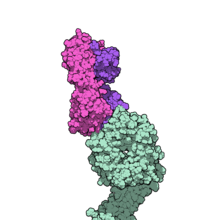This article needs more reliable medical references for verification or relies too heavily on primary sources. (November 2018) |  |
 | |
| Monoclonal antibody | |
|---|---|
| Type | Whole antibody |
| Source | Humanized (from mouse) |
| Target | alpha-4 integrin |
| Clinical data | |
| Trade names | Tysabri, others |
| Other names | AN100226M, Antegren |
| Biosimilars | natalizumab-sztn,[1] Tyruko[1][2] |
| AHFS/Drugs.com | Monograph |
| MedlinePlus | a605006 |
| License data |
|
| Pregnancy category |
|
| Routes of administration | Intravenous |
| ATC code | |
| Legal status | |
| Legal status | |
| Pharmacokinetic data | |
| Bioavailability | n/a |
| Elimination half-life | 11 ± 4 days |
| Identifiers | |
| CAS Number | |
| DrugBank | |
| ChemSpider |
|
| UNII | |
| KEGG | |
| ChEMBL | |
| CompTox Dashboard (EPA) | |
| Chemical and physical data | |
| Molar mass | 149 kg/mol |
| | |
Natalizumab, sold under the brand name Tysabri among others, is a medication used to treat multiple sclerosis and Crohn's disease.[9] It is a humanized monoclonal antibody against the cell adhesion molecule α4-integrin.[9] It is given by intravenous infusion.[9] The drug is believed to work by reducing the ability of inflammatory immune cells to attach to and pass through the cell layers lining the intestines and blood–brain barrier.[medical citation needed]
Natalizumab, is a monoclonal antibody which targets a protein called α4β1 integrin on white blood cells involved in inflammation.[10] By attaching to integrin, natalizumab is thought to stop white blood cells from entering the brain and spinal cord tissue, thereby reducing inflammation and the resulting nerve damage.[10]
The most common side effects are urinary tract infection, nasopharyngitis (inflammation of the nose and throat), headache, dizziness, nausea, joint pain and tiredness.[10]
Natalizumab was approved for medical use in the United States in 2004. It was subsequently withdrawn from the market by its manufacturer after it was linked with three cases of the rare neurological condition progressive multifocal leukoencephalopathy (PML) when administered in combination with interferon beta-1a, another immunosuppressive drug often used in the treatment of multiple sclerosis. After a review of safety information and no further deaths, the drug was returned to the US market in 2006 under a special prescription program. As of June 2009, ten cases of PML were known. However, twenty-four cases of PML had been reported since its reintroduction by October 2009, showing a sharp rise in the number of fatalities and prompting a review of the chemical for human use by the European Medicines Agency.[11] By 2010, 31 cases of PML were attributed to natalizumab while by 2018 this had risen to 757 cases.[12][13] The US Food and Drug Administration (FDA) did not withdraw the drug from the market as benefits outweigh the risks.[14] In the European Union, it has been approved only for multiple sclerosis and only by itself as the initial cases of PML, and later the fatalities, were said by the manufacturers to be linked to the use of previous medicines by the person.[15]
- ^ a b c "Tyruko (natalizumab-sztn) injection, for intravenous use" (PDF). Archived (PDF) from the original on 25 August 2023. Retrieved 25 August 2023.
- ^ a b Cite error: The named reference
Tyruko EPARwas invoked but never defined (see the help page). - ^ "Natalizumab (Tysabri) Use During Pregnancy". Drugs.com. 24 September 2019. Archived from the original on 23 November 2020. Retrieved 4 May 2020.
- ^ "FDA-sourced list of all drugs with black box warnings (Use Download Full Results and View Query links.)". nctr-crs.fda.gov. FDA. Retrieved 22 October 2023.
- ^ "Tysabri natalizumab 150 mg/1 mL injection solution pre-filled syringe (353845)". Therapeutic Goods Administration (TGA). 12 August 2022. Archived from the original on 25 August 2023. Retrieved 25 August 2023.
- ^ "Tysabri Product and Consumer Medicine Information Licence". TGA eBS. Archived from the original on 3 July 2022. Retrieved 25 August 2023.
- ^ "Tysabri Product information". Health Canada. 22 October 2009. Archived from the original on 25 August 2023. Retrieved 25 August 2023.
- ^ "Tysabri 300 mg concentrate for solution for infusion - Summary of Product Characteristics (SmPC)". (emc). 14 November 2019. Archived from the original on 22 October 2020. Retrieved 4 May 2020.
- ^ a b c d "Tysabri- natalizumab injection". DailyMed. 12 August 2019. Archived from the original on 27 March 2020. Retrieved 4 May 2020.
- ^ a b c d Cite error: The named reference
Tysabri EPARwas invoked but never defined (see the help page). - ^ "Meeting highlights from the Committee for Medicinal Products for Human Use" (PDF). European Medicines Agency. 22 October 2009. Archived from the original (PDF) on 27 December 2009. Retrieved 31 August 2010.
- ^ Jeffrey S (5 February 2010). "PML Risk Increases With Repeated Natalizumab Infusions: FDA". Medscape. Archived from the original on 26 January 2012. Retrieved 31 August 2010.
- ^ "Incidence of natalizumab-associated progressive multifocal leucoencephalopathy and its relationship with the pattern of natalizumab exposure over time". ECTRIMS. 10 October 2018. Archived from the original on 28 October 2021. Retrieved 18 July 2019.
- ^ Hitti M (1 August 2008). "MS Drug Tysabri Tied to Brain Infection". WebMD. Archived from the original on 20 November 2018. Retrieved 31 August 2010.
- ^ Staton T (26 October 2009). "Tysabri safety falls under EMEA scrutiny". Fierce Pharma. Archived from the original on 23 January 2021. Retrieved 20 November 2018.